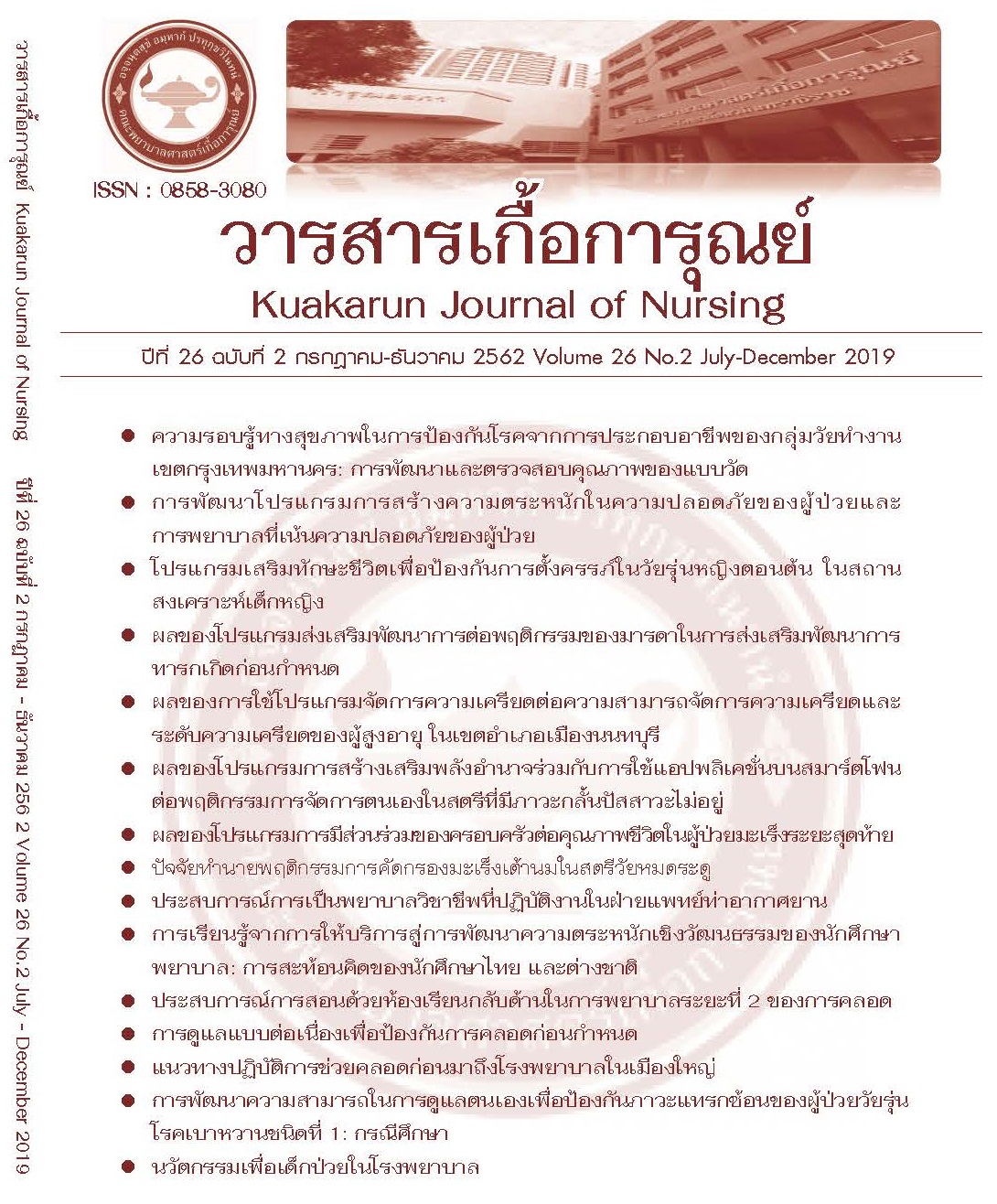การพัฒนาความสามารถในการดูแลตนเองเพื่อป้องกันภาวะแทรกซ้อนของผู้ป่วยวัยรุ่นโรคเบาหวานชนิดที่ 1: กรณีศึกษา
คำสำคัญ:
โรคเบาหวานชนิดที่ 1, วัยรุ่น, ความสามารถในการดูแลตนเองบทคัดย่อ
การศึกษานี้เป็นการศึกษาการให้การพยาบาลผู้ป่วยวัยรุ่นโรคเบาหวานชนิดที่ 1 จำนวน 2 ราย มีวัตถุประสงค์เพื่อศึกษาแนวทางการพัฒนาความสามารถในการดูแลตนเองของผู้ป่วยวัยรุ่นโรคเบาหวาน ชนิดที่ 1 เพื่อป้องกันภาวะแทรกซ้อน ที่มารับการรักษาที่แผนกกุมารเวชกรรม โดยใช้ทฤษฎีความพร่องในการดูแลตนเอง (Orem & Taylor, 1986) ซึ่งช่วยให้พยาบาลมีเป้าหมายและวิธีการในการดูแลผู้ป่วยและครอบครัวได้ชัดเจนมากขึ้น
ผลการศึกษา พบว่า ผู้ป่วยวัยรุ่นทั้ง 2 ราย มีประเด็นปัญหาทางการพยาบาลที่สำคัญเหมือนกัน คือ มีความรู้ความเข้าใจในเรื่องการฉีดยาอินซูลิน การรับประทานอาหาร และการออกกำลังกายไม่เพียงพอ และมีโอกาสลดความพยายามในการดูแลตนเองอย่างต่อเนื่องจากการขาดกำลังใจและขาดความมั่นใจ การพยาบาลที่สำคัญ ได้แก่ การให้การสนับสนุน ให้กำลังใจ ให้ความรู้เกี่ยวกับโรคเบาหวาน การฝึกทักษะให้สามารถดูแลตนเองได้ในเรื่องการฉีดอินซูลิน การคำนวณสารอาหารที่ได้รับในแต่ละวัน การออกกำลังกายที่เหมาะสม การสังเกตอาการเปลี่ยนแปลงที่อาจเกิดขึ้น การใช้เครื่องมือในการติดตามอาการเปลี่ยนแปลงของตนเอง และสามารถช่วยเหลือตนเองได้เบื้องต้น
การพยาบาลเพื่อพัฒนาความสามารถในการดูแลตนเองของผู้ป่วยวัยรุ่นควรส่งเสริมให้เร็วที่สุดเท่าที่วัยรุ่นสามารถทำได้ และให้โอกาสผู้ป่วยวัยรุ่นมีส่วนร่วมในการดูแลตนเองมากที่สุดร่วมกับผู้ดูแล โดยการสนับสนุน ให้กำลังใจ จนกระทั่งสามารถดูแลตนเองได้อย่างสมบูรณ์ ไม่เกิดภาวะแทรกซ้อน
เอกสารอ้างอิง
นิพาวรรณ ไวศยะนันท์ และเบญจมาศ สุขสถิต. (2560). การบริหารอินซูลินด้วยตนเองในผู้ป่วยเบาหวานชนิดที่ 1. วารสารพยาบาลทหารบก, 18(1), 11-21.
บัญจางค์ สุขเจริญ. (2555). การพยาบาลผู้ป่วยเด็กที่มีปัญหาต่อมไร้ท่อ. ตำราการพยาบาลเด็ก เล่ม 2. กรุงเทพมหานคร: โครงการตำราคณะพยาบาลศาสตร์ มหาวิทยาลัยมหิดล.
ปิยนันท์ เทพรักษ์. (2557). ผลของโปรแกรมการใช้แบบแผนความเชื่อด้านสุขภาพร่วมกับการส่งเสริม ความสามารถของตนโดยพยาบาลลดระดับฮีโมโกลบินเอวันซี. กรุงเทพมหานคร: โรงพยาบาลศิริราช.
วารุณี สันป่าแก้ว, วนิดา เสนะสุทธิพันธุ์, พรรณรัตน์ แสงเพิ่ม และสุภาวดี ลิขิตมาศกุล. (2557). ความสัมพันธ์ระหว่างการสนับสนุนทางสังคมและปัจจัยบางประการกับพฤติกรรมการบริโภคอาหารของวัยรุ่นเสี่ยงต่อโรคเบาหวาน. วารสารเกื้อการุณย์, 21(1), 186-204.
วิชัย เอกพลากร. (2557). การสำรวจสุขภาพประชากรไทยโดยการตรวจร่างกาย ครั้งที่ 5. สถาบันวิจัยระบบสาธารณสุข กระทรวงสาธารณสุข สำนักงานกองทุนสนับสนุนการเสริมสร้างสุขภาพ.
สมจิต หนุเจริญกุล (2544). การประยุกต์ใช้ทฤษฎีการพยาบาลของโอเร็ม. พิมพ์ครั้งที่ 6. การดูแลตนเอง: ศาสตร์และศิลปะทางการพยาบาล. กรุงเทพฯ: วี.เจ.พริ้นติ้ง
สมาคมโรคเบาหวานแห่งประเทศไทยในพระบรมราชูปถัมภ์ สมเด็กพระเทพ. (2558). คู่มือการฉีดอินซูลิน. ครั้งที่ 2. กรุงเทพฯ
สมาคมโรคเบาหวานแห่งประเทศไทยในพระบรมราชูปถัมภ์ สมเด็กพระเทพ. (2560). แนวทางเวชปฏิบัติสำหรับโรคเบาหวาน 2560. ปทุมธานี: ร่มเย็น มีเดีย.
ศิริโสภา จรรยาสิงห์, พรศรี ศรีอัษฎาพร, อาภาวรรณ หนูคง,อัจฉรา เปรื่องเวทย์ และสุภาวดี ลิขตมาศกุล (2555). โครงการศึกษานำร่องผลของโปรแกรมการสร้างพลังใจของผู้ดูแลต่อการควบคุมเบาหวานที่บ้านในเด็กเบาหวานที่ควบคุมไม่ดี. วารสารพยาบาลศาสตร์, 29(2), 65-73.
อัจฉรา จินดาวัฒนวงศ์, นพวรรณ เปียซื่อ และ พัชรินทร์ นินทจันทร์. (2555). ความสัมพันธ์ระหว่างการรับรู้ความเชื่อด้านสุขภาพกับพฤติกรรมการป้องกันโรคเบาหวานชนิดที่ 2 ในนักเรียนมัธยมศึกษาตอนปลาย. รามาธิบดีวารสาร, 18(1), 58-69.
American Diabetes Association of Thailand. Standards of Medical Care in Diabetes 2016. Diabetes Care 2016, 39(1), 99-106.
Dabelea, D., Mayer-Davis, E. J., Saydah, S., Imperatore, G., Linder, B., Divers, J., Hamman, R. F. (2014). Prevalence of type 1 and type 2 diabetes among children and adolescents from 2001 to 2009. Jama, 311(17), 1778-1786.
Jerica M Berge, Melanie Wall, Nicole Larson, Katie A Loth, Dianne Neumark-SZtainer. (2013). Journal of adolescent health, 52(3), 351-357.
Orem, D.E. (1991). Nursing: concepts of practice. (4th ed.) Philadelphia: Mosbe Year Book.
Orem, D.E., Taylor G.S. (2001) Nursing: concept of practice. 6th ed. St. Louis: Mosby.
World Health Organiation. (2012). Retrieved May 10, 2018, from
www.who.int/dietphysicalactivity/publications/facts/diabetes/en/















